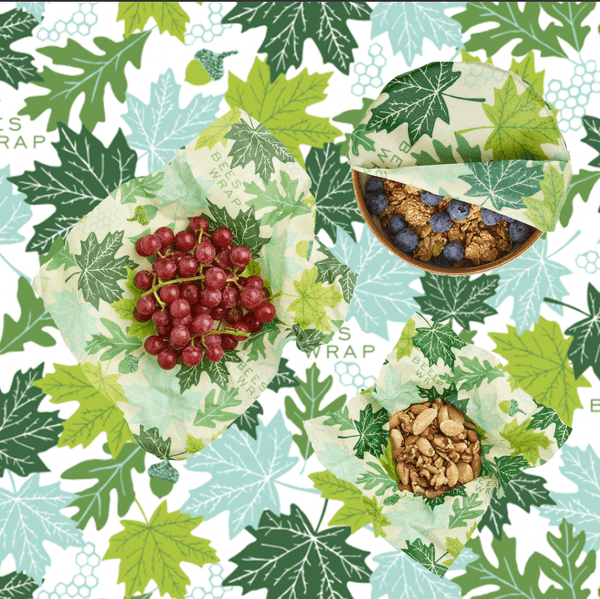How to Keep Your Food Fresh Longer

You’re staying home and taking care of your loved ones. You’re converting your kitchen table into makeshift office space and a temporary classroom. You’re putting social distancing into practice.
This new reality means slowing down and staying healthy. That includes fewer trips to the grocery store and getting more mileage out of meals. Properly storing fruits, vegetables, herbs, bread, and leftovers can help keep your refrigerator and pantry well-stocked during this challenging time.
Here are some easy ways to store fruit, vegetables, herbs, and bread with Bee's Wrap that will keep your food tasting fresh.
Berries
Berries are everyone’s favorite until mold makes an appearance. For longer shelf life, rinse blueberries, raspberries, and strawberries in a mix of vinegar and water (1 part vinegar, 2 parts water) to disinfect against mold. Rinse in plain water, and be sure your berries are dry before wrapping and refrigerating (try folding a medium or large wrap into a pouch!) Avoid storing in the crisper drawer to stave off humidity.

Apples
Sliced apples are a perfect go-to snack, but leftovers can turn brown and mushy quickly, thanks to ethylene gas—a natural plant hormone that sets off the ripening process. To keep apple slices longer, soak them in a bowl of cold salt water to prevent oxidation—but use no more than a half-teaspoon of salt per quart of water. After five minutes, dry and use a small wrap for your slices and store in the fridge.
Bananas
Ethylene gas is also what causes bananas to ripen. To slow the process, separate each banana from the bunch and wrap each individual stem to stop the spread of ethylene gas. If your bananas are already too ripe for your taste, peel, wrap, and store them in the freezer for a future smoothie treat.
Oranges
Oranges will keep for a couple of days at room temperature, but the best way to store them is in the refrigerator. Oranges keep well at room temperature for about one week. Any longer will cause the oranges to wrinkle and lose flavor. If you wrap and refrigerate, oranges will typically keep for about 3 to 4 weeks.

Lemons
If the dish or drink you’re making requires just a squeeze of lemon, puncture the whole lemon with a fork rather than cutting it in half. Squeeze what you need without drying out the whole lemon. To store, wrap and refrigerate.
Avocados
Enzymes in avocado produce a brown pigment when exposed to oxygen. It doesn’t take long for half an avocado or a bowl of guacamole to look less than appealing. To avoid browning, use a dash of lemon or lime juice. The citric acid will help prevent browning for at least 24 hours. You can also try storing avocado slices with large chunks of onion for preservation. Just be sure the onion touches only the skin of the avocado.
Carrots
Carrots can look tired pretty quickly. To make them last, chop off the leafy greens if you bought them whole. Carrots do best with moisture. So, for best results, put them in a bowl filled with water, seal with a large wrap and store in the refrigerator.

Tomatoes
Whether you store tomatoes in the refrigerator or on your counter, it’s important to cover the stem end of a tomato—if it’s already fully detached from the stem and vine—to delay spoiling. You can flip the tomatoes upside down on the counter, or place a piece of tape over the stem scar. Ripe tomatoes can stay on the counter in a single layer as long as they are not touching each other. Overripe tomatoes will fare better in your fridge. Before eating refrigerated tomatoes, take them out of the fridge and let them come to room temperature to restore flavor.
Lettuce
Store leftover leaves in a bowl with a paper towel on top, then seal with a reusable food wrap. Moisture is the culprit for turning leaves soggy and brown, so the paper towel works to absorbs moisture. Replace the towel when it becomes damp. Also, try putting a dash of salt on the lettuce, which also helps draw out extra wetness.
Herbs
If you buy herbs at the grocery store, remove all packaging as well as any brown or slimy bits. Rinse in cold water quickly and thoroughly, then blot them dry. A salad spinner can help remove additional water. Transfer the herbs in a single layer. Wrap and place in the fridge, preferably in the crisper drawer.

Bread
A fresh loaf of bread is best eaten within a few days. Freezing is the best way to preserve bread for the longest time possible. If you’re planning on eating your bread within a few days, keep it stored in a cool and dry area (not on top of the refrigerator or near the dishwasher). A reusable bread wrap or bread bag is your best bet for freezing and storing.
Made in Vermont, Bee’s Wrap is made with organic cotton muslin, beeswax, jojoba oil, and tree resin. This combination of ingredients creates a malleable food wrap that can be used over and over. Washable, reusable, and compostable, Bee’s Wrap allows food to breathe and keeps food fresher for longer.






